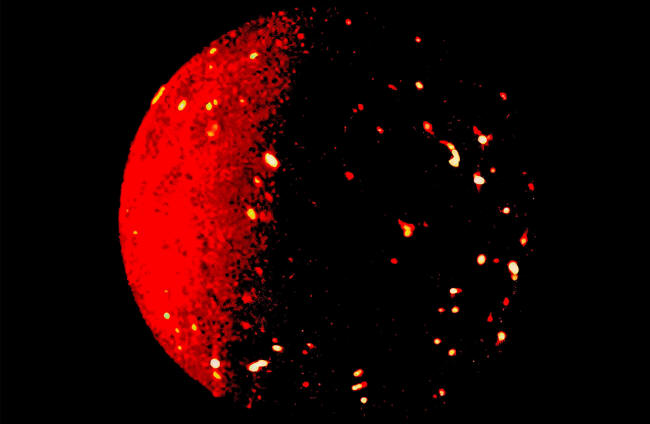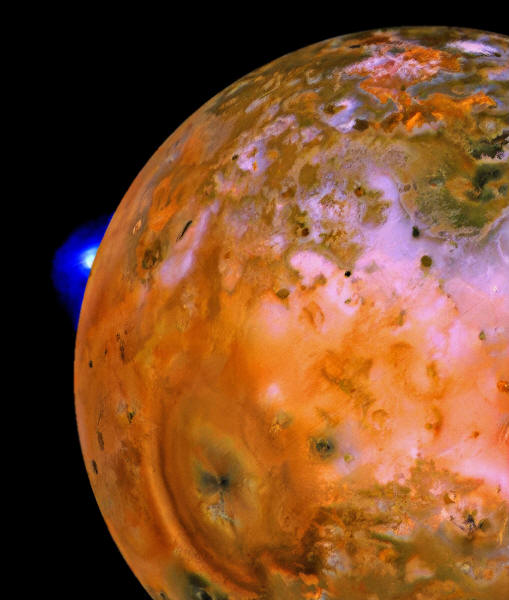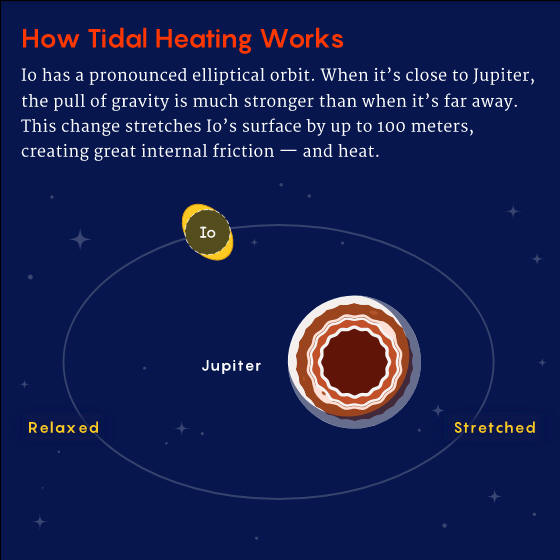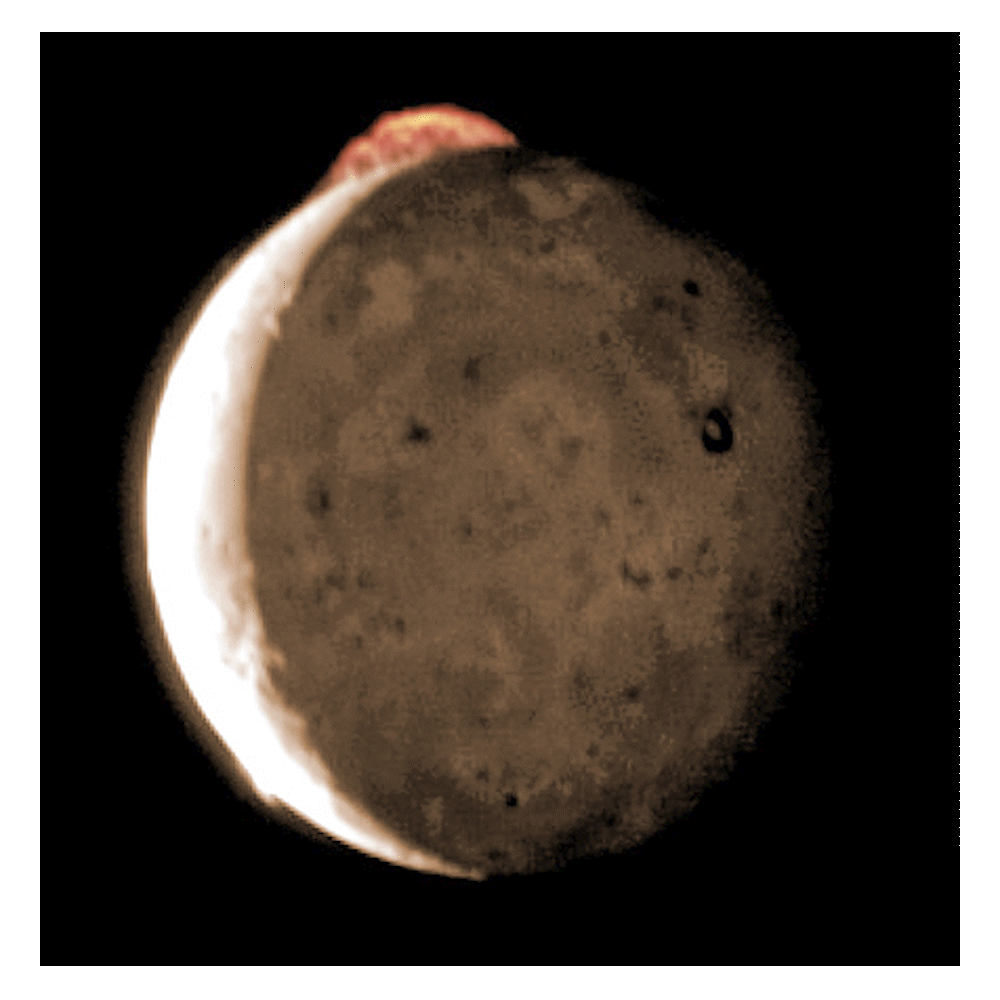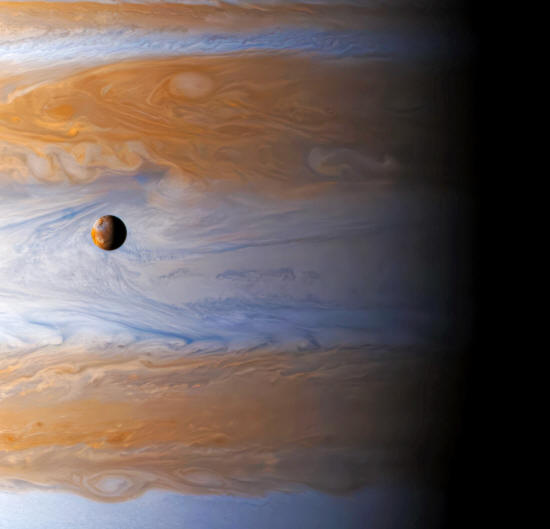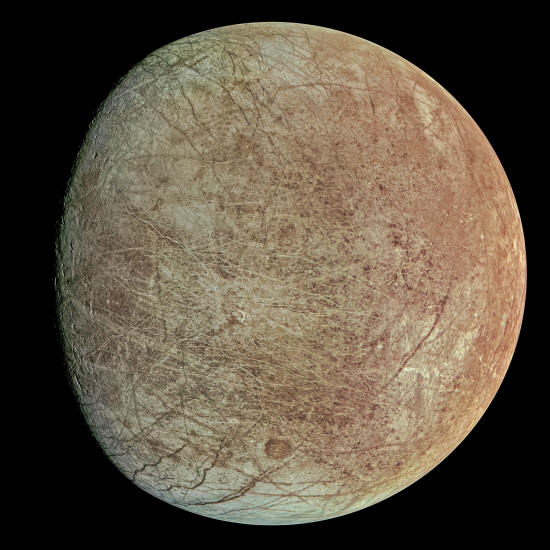|
in this
infrared image captured by NASA's Juno probe. refute a leading theory of its inner structure and reveal how little is understood about geologically active moons...
The Voyager 1 spacecraft had flown past this moon of Jupiter, catching the first glimpse of active volcanism on a world other than Earth.
Umbrella-shaped outbursts of magmatic matter rocketed into space from all over Io's surface.
Scientists like Bolton have been trying to understand Io's exuberant volcanism ever since.
A leading theory has been that just below the moon's crust hides a global magma ocean, a vast contiguous cache of liquid rock.
This theory dovetails neatly with several observations, including ones showing a roughly uniform distribution of Io's volcanoes, which seem to be tapping the same omnipresent, hellish source of melt.
But now, it appears that Io's hell has vanished - or rather, it was never there to begin with.
During recent flybys of the volcanic moon by NASA's Juno spacecraft, scientists measured Io's gravitational effect on Juno, using the spacecraft's tiniest wobbles to determine the moon's mass distribution and therefore its internal structure.
The scientists reported in Nature that nothing significant is sloshing about just beneath Io's crust.
Independent scientists can find no fault with the study.
The data has reopened a mystery that spills over into other rocky worlds. Io's volcanism is powered by a gravity-driven mechanism called tidal heating, which melts the rock into magma that erupts from the surface.
Whereas Io is the poster child for this mechanism, tidal heating also heats many other worlds, including Io's neighbor, the icy moon Europa, where the heat is thought to sustain a subterranean saltwater ocean.
NASA launched the $5 billion Clipper spacecraft to search Europa's sky for signs of life in the proposed underground ocean.
A map of Io's surface, created with images from the Voyager 1 and Galileo missions, shows the wide distribution of the moon's volcanoes. The large red ring is sulfurous fallout
from the plume of the
Pele volcano.
But if Io doesn't have a magma ocean, what might that mean for Europa?
And, scientists now wonder,
Melting Magma
Heat drives geology, the rocky foundation upon which everything else, from volcanic activity and atmospheric chemistry to biology, is built.
Heat often comes from a planet's formation and the decay of its radioactive elements.
But smaller celestial objects like moons have only tiny reserves of such elements and of residual heat, and when those reserves run dry, their geological activity flatlines.
Or, at least, it should - but something appears to grant geologic life to small orbs throughout the solar system long after they should have geologically perished.
Io is the most flamboyant member of this puzzling club - a burnt-orange, crimson and tawny Jackson Pollock painting.
The discovery of its over-spilling cauldrons of lava is one of the most famous tales in planetary science, as they were predicted to exist before they were discovered.
NASA's Voyager 1 probe photographed Io in 1979, revealing the first glimpse of volcanism beyond Earth. In this photo mosaic, a lava plume is seen emanating from Loki Patera,
now known to be the
moon's largest volcano.
On March 2, 1979, a paper in Science ruminated on Io's strange orbit.
Because of the positions and orbits of neighboring moons, Io's orbit is elliptical rather than circular. And when Io is closer to Jupiter, it experiences a stronger gravitational pull from the gas giant than when it is farther away.
The study authors figured that Jupiter's gravity must therefore be constantly kneading Io, pulling its surface up and down by up to 100 meters, and, per their calculations, generating a lot of frictional heat within it - a mechanism they described as "tidal heating."
They conjectured that Io may be the most intensely heated rocky body in the solar system.
Just three days later, Voyager 1 flew by.
An image taken on March 8 documented two gigantic plumes arching above its surface. After ruling out all other causes, NASA scientists concluded that Voyager had seen an alien world's volcanic eruptions.
They reported their discovery in Science that June, just three months after the prediction.
The planetary science community quickly coalesced around the idea that tidal heating within Io is responsible for the never-ending volcanism on the surface.
Where is that tidal heating focused within Io, and just how much heat and melting is it generating?
Mark Belan Quanta Magazine
NASA's Galileo spacecraft studied Jupiter and several of its moons around the turn of the millennium.
One of its instruments was a magnetometer, and it picked up a peculiar magnetic field emanating from Io. The signal appeared to be coming from an electrically conductive fluid - a lot of fluid, in fact.
After years of study, scientists concluded in 2011 that Galileo had detected a global magma ocean just below Io's crust.
Whereas Earth's mantle is mostly solid and plasticky, Io's subsurface was thought to be filled with an ocean of liquid rock 50 kilometers thick, or almost five times thicker than the Pacific Ocean at its deepest point.
A similar magnetic field was coming from Europa, too - in this case, apparently generated by a vast ocean of salty water.
The implications were profound:
Volcanic Vanishing Act
By the time the Juno spacecraft started swinging around Jupiter in 2016, the belief that Io had a magma ocean was widespread.
But Bolton and his colleagues wanted to double-check.
A sequence of images taken over the course of eight minutes by NASA's New Horizons probe in 2007 shows an eruption by the Tvashtar Paterae volcanic region. The plume in this false-color image
rises 330 kilometers
from the moon's surface. Applied Physics Laboratory/ Southwest Research Institute
During flybys in December 2023 and February 2024, Juno came within 1,500 kilometers of Io's scorched surface.
Although the remarkable images of active volcanoes drew everyone's attention, the goal of these flybys was to find out if a magma ocean truly lay beneath the moon's rocky skin.
To investigate, the team used an unlikely tool:
Because of Io's unevenly distributed mass, its gravitational field isn't perfectly symmetrical. That uneven gravitational field subtly alters the motion of Juno as it flies by, causing it to accelerate or decelerate a little.
That means Juno's radio transmissions will experience the Doppler effect, where the wavelength shifts slightly in response to Io's uneven gravitational field.
By looking at the incredibly small shifts in the transmissions, Bolton's team was able to create a high-fidelity picture of Io's gravitational field and use that to determine its internal structure.
But Bolton's team did not find this level of distortion.
Their conclusion was clear.
The Cassini-Huygens mission photographed Io against the backdrop
of Jupiter in 2001.
So what else might be powering Io's volcanoes?
On Earth, discrete reservoirs of magma of different types - from the tarlike viscous matter that powers explosive eruptions to the runnier, honey-esque stuff that gushes out of some volcanoes - are located within the crust at various depths, all created by the interactions of tectonic plates, the moving jigsaw pieces that make up Earth's surface.
Io lacks plate tectonics and (perhaps) a diversity of magma types, but its crust may nevertheless be peppered with magma reservoirs. This was one of the original lines of thought until Galileo's data convinced many of the magma ocean theory.
The new study doesn't rule out a far deeper magma ocean.
But that abyssal cache would have to be filled with magma so iron-rich and dense (because of its great depth) that it would struggle to migrate to the surface and power Io's volcanism.
For some, this raises an irreconcilable problem.
Galileo's magnetometer detected signs of a shallow magma ocean, but Juno gravity data has emphatically ruled that out.
Researchers disagree on the best interpretation of the Galileo data.
The magnetic signals,
The induction data couldn't distinguish between a partly molten (but still solid) interior and a fully molten magma ocean, he said.
Heavy Water
Perhaps the main reason scientists study Io is because it teaches us about the fundamentals of tidal heating. Io's tidal heating engine remains impressive - there's clearly a lot of volcano-feeding magma being generated.
But if it's not producing a subsurface magma ocean, does that mean tidal heating doesn't generate water oceans, either?
Nobody doubts that Saturn's moon Enceladus, which is also tidally heated, contains an underground saltwater ocean:
And although there is some light skepticism about whether Europa has an ocean, most scientists think it does.
The smooth, lightly scratched surface of Jupiter's icy moon Europa, photographed by the Juno spacecraft in 2022, shows no sign of what lies beneath:
in all likelihood, a
vast saltwater ocean.
Crucially, unlike Io's odd magnetic field, which seemed to indicate that it concealed an ocean's worth of fluid, Europa's own Galileo-era magnetic signal remains robust.
The icy moon is far enough from Jupiter and the intense plasma-flooded space environment of Io that Europa's own magnetic induction signal "really sticks out."
But if both moons are tidally heated, why does only Europa have an inner ocean?
According to Nimmo,
Liquid rock is less dense than solid rock, so it wants to rise and erupt quickly; the new study suggests that it doesn't linger at depth long enough inside Io to form a massive, interconnected ocean.
But liquid water is, unusually, denser than its solid icy form.
Tidal heating might struggle to create magma oceans.
But on icy moons, it can easily make watery oceans due to the bizarrely low density of ice. And that suggests life has a multitude of potentially habitable environments throughout the solar system to call home.
Hell's Poster Child
The revelation that Io is missing its shallow magma ocean underscores just how little is known about tidal heating.
Our own moon shows evidence of primeval tidal heating, too.
Its oldest crystals formed 4.51 billion years ago from the stream of molten matter that got blasted off Earth by a giant impact event. But a lot of lunar crystals seem to have formed from a second reservoir of molten rock 4.35 billion years ago.
Where did that later magma come from?
Nimmo and co-authors offered one idea in a paper published in Nature in December:
At a certain threshold, when the gravitational influence of both were roughly equal, the moon might have temporarily adopted an elliptical orbit and gotten tidally heated by Earth's gravitational kneading.
Its interior might have remelted, causing a surprise secondary flourish of volcanism.
But exactly where within the moon's interior its tidal heating was concentrated - and thus, where all that melting was happening - isn't clear.
Perhaps if Io can be understood, so too can our moon - as well as several of the other satellites in our solar system with hidden tidal engines.
For now, this volcanic orb remains maddeningly inscrutable.
|


